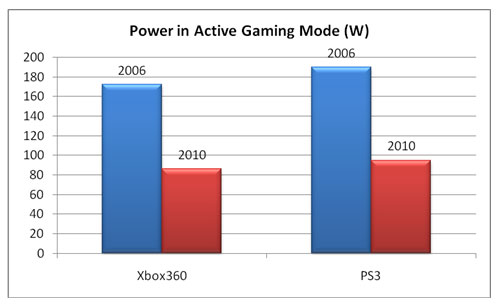
|
Video Game Consoles Now More Efficient
|
Manufacturers Cut Energy Usage of Video Game Consoles By Half
NRDC Analysis Reveals Industry Shift Toward Energy-Saving Products
SAN FRANCISCO, CA (June 8, 2011) - The newest models of leading video game consoles use 50% less energy today than their 2006 predecessors, saving consumers money in the form of lower electricity bills, according to new analysis by the Natural Resources Defense Council. While both the Sony PlayStation 3 and Microsoft Xbox 360 each consumed roughly 180 Watts of power during game play when first introduced in the market, the latest releases of both systems now use around 90 Watts, demonstrating energy efficient technologies can be quickly implemented in the electronics industry.
"Sony and Microsoft have proven that significant energy savings can be achieved without sacrificing user experience," said Noah Horowitz, senior scientist at the NRDC. "Consumers want and deserve technologies without hidden costs. We're glad that industry is responding to that desire, and hope efficiency someday becomes the rule, not the exception."
NRDC's new analysis is a follow-up to its 2008 in-depth video game study, "Lowering the Cost of Play: Improving the Energy Efficiency of Video Game Consoles," (pdf file) which examined the energy use of consoles like the PS3, Xbox 360, and Nintendo Wii. Results of the study were staggering: most notably, a high-end video game console made in 2008 would consume as much electricity each year as two new refrigerators, if the device were not turned off when not in use.
However, Microsoft and Sony have taken bold steps to slash the energy consumption of their consoles, demonstrating the growing focus among video game console makers on producing and marketing energy efficient products (see bar chart below). The current version of the Nintendo Wii uses less than 25Watts and no data is available yet on the energy use of the new Wii U that was just introduced.

While efficiency improvements to the PS3 and Xbox 360 will bring significant savings, additional measures can be taken by console makers to further reduce the annual energy use of their devices. NRDC recommendations include:
Rev it Down: Current video game consoles use approximately 80% as much power in Menu mode, when they hardly have any graphics to process, compared to that consumed during active game play. The next generation of consoles should rev down to 20-40% of maximum power use when not performing graphics-intensive tasks, and down to 1 Watt or less when turned off. This would significantly reduce the annual energy use and electricity costs of video game consoles without any impact on their performance.
Sleep Mode & Auto Save Capabilities: Manufacturers can also achieve large energy savings by ensuring that new video game consoles go into sleep mode when not in use. And game publishers should continue to work with console makers to implement auto save capabilities that allow users to keep their place in the game when the device is turned off and to easily restore their place in the game when they return. While the Xbox 360 and PS3 now ship with software that causes the device to consume very low levels of power when not in use, Sony and Microsoft both ship their devices with this feature disabled. Through the menu settings, users can physically turn this auto power down feature on, saving up to $50 to $100 a year in energy costs.
Consoles Should Use Less Energy to Display Movies: One of the key selling points of the PS3 is that you can play Blu Ray discs on it - essentially giving consumers a Blu Ray player for free. Today, all three consoles also allow you to stream or download movies from the internet. While seemingly a great advancement, console makers have not yet incorporated state of the art designs to make this happen efficiently. It should not take more than 25 Watts to play a movie on a video game console, levels much closer to today's stand-alone DVD players. In contrast, today's PS3 consumes more than 7 times more power to playback a movie than an energy efficient Blu Ray player (70 Watts to play Spiderman 3 disc on PS3, while it only takes 10 Watts or so on a new energy efficient Blu Ray disc player).
For industry recommendations on how to reduce the energy use of video game consoles, see NRDC Senior Scientist Noah Horowitz's blog and NRDC's 2008 report "Lowering the Cost of Play: Improving the Energy Efficiency of Video Game Consoles." (pdf file)
The Natural Resources Defense Council (NRDC) is an international nonprofit environmental organization with more than 1.3 million members and online activists. Since 1970, our lawyers, scientists, and other environmental specialists have worked to protect the world's natural resources, public health, and the environment. NRDC has offices in New York City, Washington, D.C., Los Angeles, San Francisco, Chicago, Livingston, Montana, and Beijing. Visit us at www.nrdc.org.
  
|









